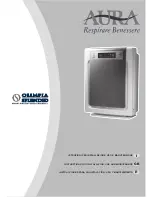
20
R-410A is an azeotropic mixture of HFC-32 and HFC-125. It has been developed as a long-term replacement for R-22 in a variety of
new air conditioning and cooling equipment. R-22 is an HCFC, or hydro chlorofluorocarbon, which means that it contains chlorine,
an element that is depleting to the ozone layer. Because R-410A contains no chlorine at all, its ozone depletion potential (ODP) is
zero. R-410A comes in rose-coloured cylinders. The “rose” colour is PMS (Pantone Matching System) 507.
As with any refrigerant, there are certain safety precautions that the technician needs to understand and observe. This article
describes typical applications, recycling/recovery procedures and equipment, and precautions applicable to this new refrigerant
product.
6.1
Typical Applications
Major applications for R-410A include unitary air conditioning equipment, chillers, and commercial refrigeration systems. In unitary
residential and light commercial systems, R-410A has demonstrated a 5 to 6% higher energy efficiency rating (EER) than R-22. Its
higher cooling capacity permits smaller, more compact units to be used.
Because of the significantly higher pressures associated with R-410A, a typical compressor designed for R-22 cannot be used with
R-410A. As noted previously, this fact—along with other components in the system that would need to be changed—renders the
refrigerant inappropriate for retrofit of existing R-22 systems.
Another important issue is the compatibility of the compressor lubricant with the azeotropic R-410A mixture. To ensure satisfactory
operation and durability, a polyester based lubricant that is miscible with the refrigerant is recommended.
Compressor manufacturers are continuing to test and recommend specific lubricants for use with R-410A. It is therefore important
to contact the compressor and/or equipment manufacturer to review system lubricant requirements.
It is also important to review materials with which the refrigerant will come in contact, including motor windings in hermetic and
semi-hermetic compressors, gaskets, etc., for compatibility.
R-410A and R-22 are chemically compatible—which means that they will not react or form other compounds if accidentally mixed—
but they will form a mixture that can be difficult to separate.
At this time, separation cannot be accomplished by any known on-site recovery device or in the facilities of most offsite reclaimers.
Disposal of the mixture by incineration is recommended.
In order to prevent the damage to equipment that can be caused by charging with contaminated refrigerant, cross contamination
(the mixing of R-410A with other refrigerants) should be avoided during recovery and recycling. Recovery equipment includes not
only the recovery/recycling machine itself, but also all equipment that comes into contact with the refrigerant during recovery and
reclamation. This may include hoses, storage cylinders, vacuum pumps, manifold gauges, and scales.
To eliminate the possibility of cross contamination, the technician should use recovery/recycling devices with self-purging or
evacuation features. Such equipment contains special valves that work with internal compressors to remove refrigerant by creating
a partial vacuum in the tanks and hoses, thus allowing for the complete removal and diversion of materials into the recovery cylinder.
Hoses, cylinders, and manifold gauges should either be dedicated to R-410A or evacuated after each recovery job. All equipment
should be clearly marked to indicate the formulation for which it can be used, and all new cylinders should be evacuated prior to the
first use.
Proper maintenance of vacuum pumps, used to remove non condensable gases and moisture from a system, is equally important.
New (clean) oil specifically formulated for vacuum pumps should be used at the start of each procedure. The oil should be changed
at intervals as recommended by the manufacturer, or more frequently if it takes on a milky or cloudy appearance. An isolation valve
is an absolute necessity for checking system integrity. In addition, worn O-rings and hoses should be replaced to ensure minimal
manifold leakage during evacuation. Vacuum pumps should be capable of pulling a vacuum of 300 to 500 microns. Scales are
sometimes used during recovery to prevent tank overfilling. If the scale is equipped with an automatic solenoid shut off, it must be
purged prior to each use.
6.2
Safety Precautions
Because it is heavier than air, R-410A vapours can accumulate at ground level. If a large release of vapour occurs, the vapour may
displace the oxygen available for breathing, resulting in suffocation. Although smaller leaks pose no acute health hazards, exposure
to levels of more than 1,000 parts per million (the same limit as R-22) can be harmful. Symptoms of exposure to dangerous levels
of R-410A include dizziness, headache, confusion, cardiac irregularities, and loss of consciousness in extreme cases. If a leak is
present or suspected, a suitable leak detector should be used to determine the need for ventilation or respiratory protection.
Summary of Contents for ZS12V70CCHI
Page 1: ...EN Service Manual Split Type Air Conditioner ...
Page 61: ...EN ...
















































